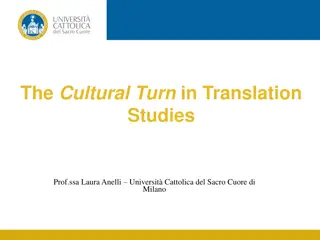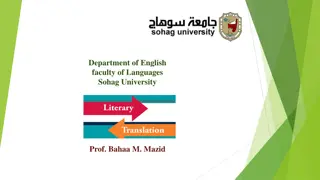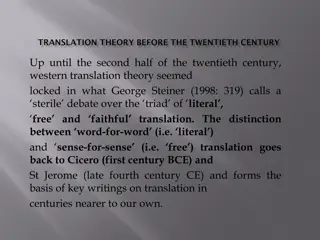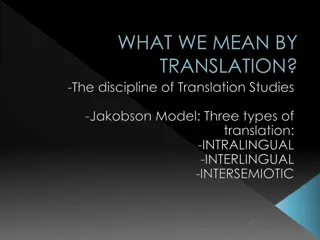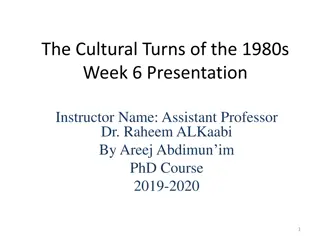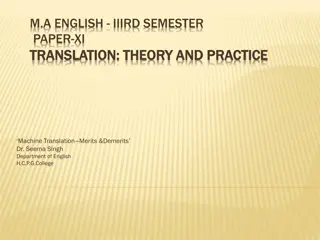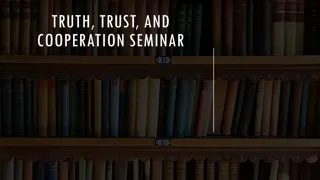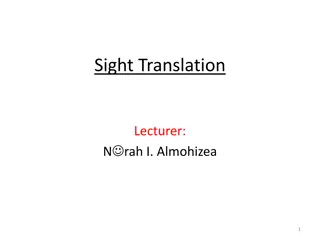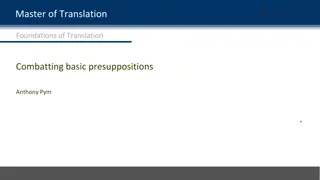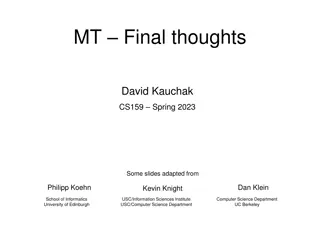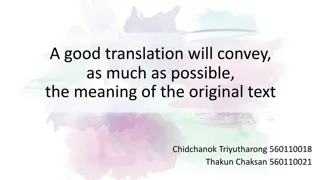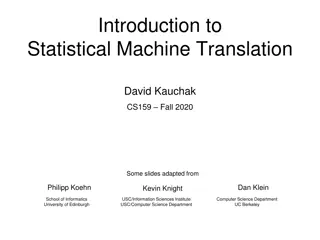
Translation: Capturing Meaning Across Languages
Explore the intricate process of translation, where meaning is transferred between source and target languages. Learn how translators navigate denotation and connotation to convey the essence of a text effectively.
Download Presentation

Please find below an Image/Link to download the presentation.
The content on the website is provided AS IS for your information and personal use only. It may not be sold, licensed, or shared on other websites without obtaining consent from the author. If you encounter any issues during the download, it is possible that the publisher has removed the file from their server.
You are allowed to download the files provided on this website for personal or commercial use, subject to the condition that they are used lawfully. All files are the property of their respective owners.
The content on the website is provided AS IS for your information and personal use only. It may not be sold, licensed, or shared on other websites without obtaining consent from the author.
E N D
Presentation Transcript
TRANSLATION 9/21/2024 2
What is Translation ? 9/21/2024 3
As a subject, translation is generally used to refer to all the processes and methods used to transfer the meaning of the source language text into the target language, by means of using: (1) words which already have an equivalent in Arabic language; (2) new words for which no ready-made equivalents are available in Arabic; (3) foreign words written in Arabic letters; (4) foreign words changed to suit Arabic pronunciation, spelling, and grammar. For example: 1. Speak 2. Satellite 3. Aspirin 4. Democracy 4 9/21/2024
According to (Farghal and Shunnaq:1999), translation is often regarded as a project for transferring meaning from one language to another. Here, we have two important words in this definition, that is, transferring and meaning. The first word indicates that when translating, we must deal with two languages because translation, in the standard sense, is a form of interlingual communication that involves a Source Language (SL) and Target Language (TL), i.e., the language we translate from and the language we translate into. The second word in the above definition tells us that the main concern of translators is to capture or convey meaning in interlingual communication. 9/21/2024 5
Meaning is a complex notion. Linguists usually divide meaning into denotation ( the core conceptual meaning of the word ) and connotation ( the shades of meaning that are sometimes added to the denotation of the word ). For example: The English lexical pairs die / pass away andfriend / comrade ( share the same denotations, but they differ in their connotations ) ( that is pass away expresses positive connotations that do not exist in die, and comrade has a political connotation which means communist that is completely missing in friend. It should be noted that translators are supposed to capture both denotation and connotation in their translation. 6 9/21/2024
Nida, believes that" translation is concerned with the reproduction of the closet equivalent of the source language text (SL) in the target language (TL) that means translation is based on equivalence not on transference. In Moby Thesaurus there are 120 words for the meaning of translation some of them are: Alternation, assumption, avatar, bilingual text, change, communication , consubstantiation, conversion, decipherment, decoding, diffusion, dispatch, displacement, elucidation, explanation, export, extradition, faithful translation, forwarding, gathering, import, interchange, key, metabolism, metaphrase, moving, reincarnation, rendering, restatement, rewrite, sending, transamination, transcription, transplacement, transport, etc. mutual transfer, paraphrase, 7 9/21/2024
The Importance of Translation Despite the dominant status of translation in the lives of nations, it passed through ages of flourishment and deterioration. These ups and downs in the history of translation depend mainly on many factors that may encourage the movement of translation in a certain city, country or region. Such factors may be related to the state policy, the educational institutions, the cultural movement during a certain era, the outer currents, the human factor (both together and individually) and the tools and methods that are used in the process of translating. Who is the Translator ? There are norms and standards for a mature translator and hence for a better translation; for if we are to have better translations, we should have mature translators who are able to translate efficiently any given text that lies within the domain of their translation maturity having in mind its form and content. The product of translation is the result of a series of phrases that the translator undergoes consciously or unconsciously more or less intricated according to factors such as the characteristics of the original text to be translated, the translator's intellectual and material resources, the source and target language involved, the purpose of the translation and other basically external influences such as time and physical or emotional conditions for the task. 8 9/21/2024
The Translation Cycle 1. Preparation The preparation phase includes: a. Preparing necessary references and dictionaries. b. Unifying terminology and making it available to the translators through the network. c. Translating samples from the translation texts to anticipate any problems the translators might face in their work. d. Defining the task required from every translator. 9 9/21/2024
2. Translation The process of translation includes: a. Undertaking the translation task, complying with available terminology databases. b. Commitment to the manuals on transliteration, capitalization, punctuation, etc. c. Reporting any mistake in the Arabic text, and any problems in the terminology or consistency issues. d. Undertaking ample investigation in case the text contains any ambiguities. e. Checking the grammar and spelling. 10 9/21/2024
3. Revision The process of revision includes: a. Insuring that the translation is sound and correct. b. Eliminating structural mistakes. c. Checking the spelling. d. Reporting on the performance of translators. 4. Editing The process of editing includes: a. Guaranteeing the readability and understandability of English texts. b. Insuring the soundness and correctness of style. c. Revision and editing by a native speaker. d. Excluding vague words and words with double-cross meaning. 11 9/21/2024



